Positioning and Synchronicity on Paper
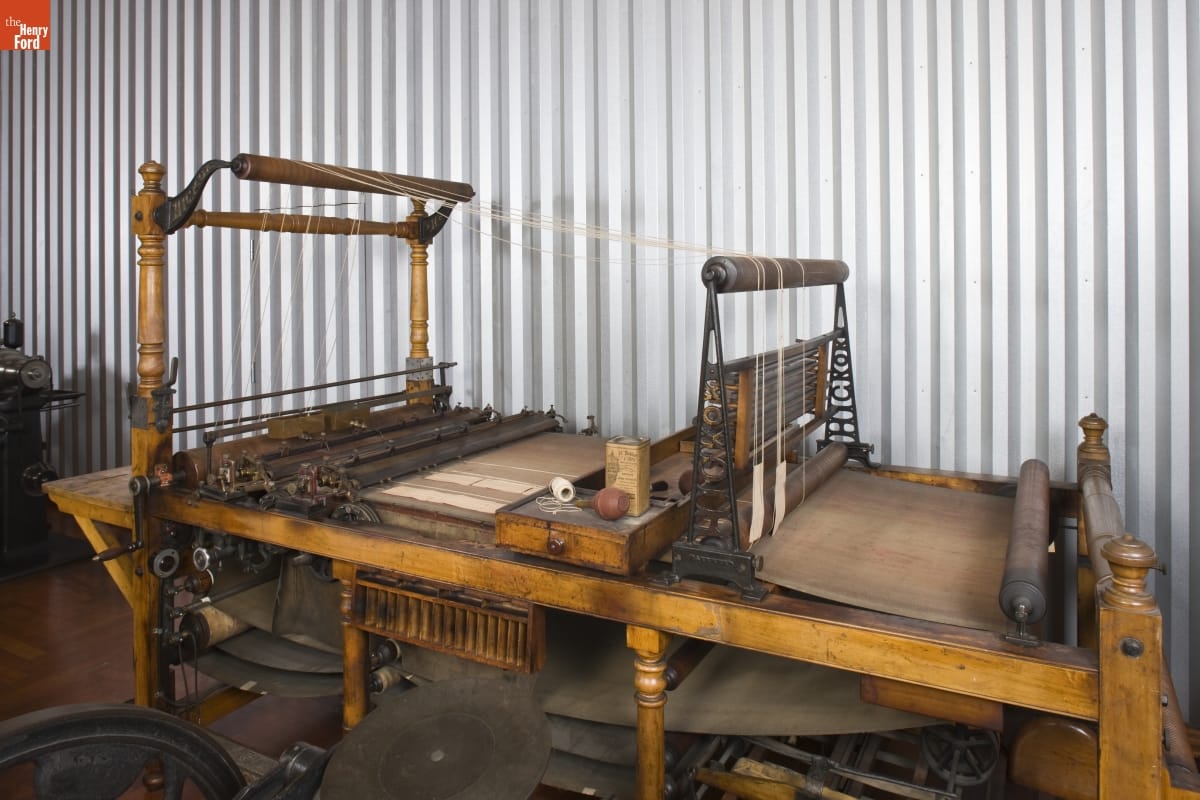
THF91558 (Photographed by John Sobczak)
In the early 19th century, lined paper was generally used only in business ledgers and account books. And the ruling was done by hand using cylindrical rulers and dip pens. Imagine the tedious hours that went into ruling just one book, with multiple colored lines as well as many stop lines, cross lines and sets of double as well as single lines.
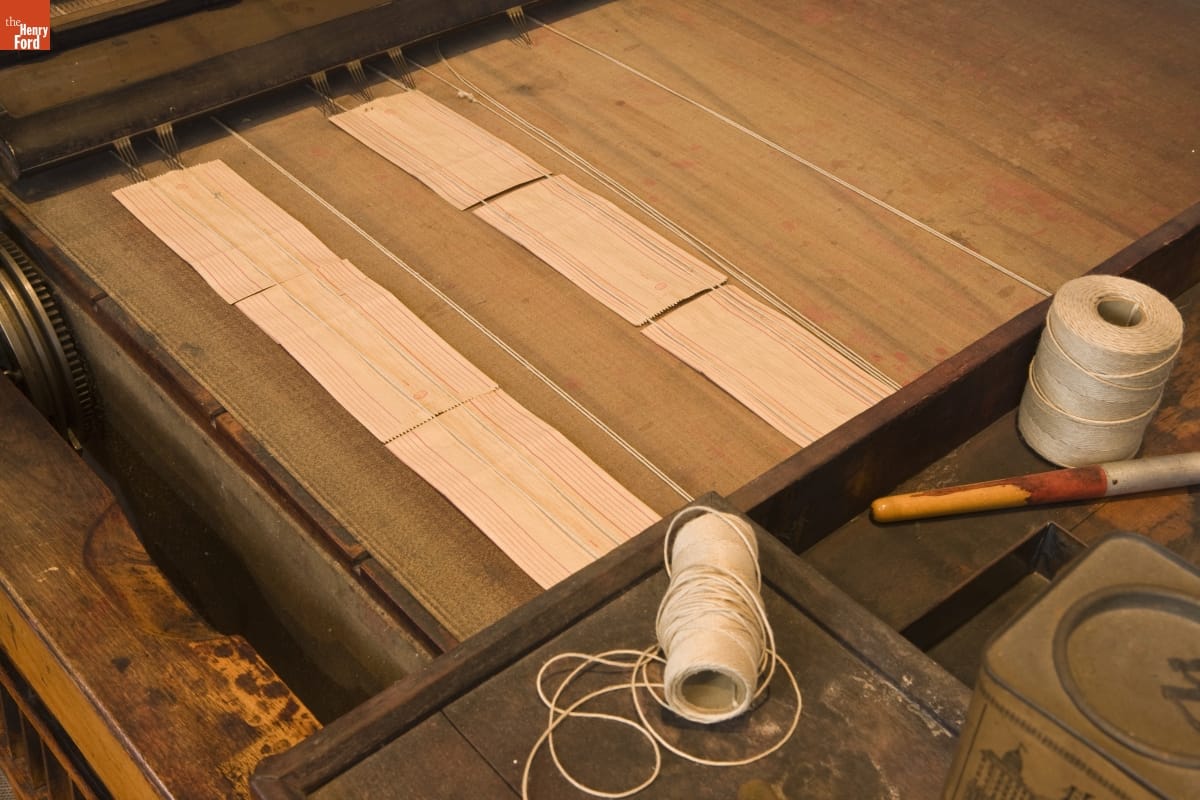
In the 1840s, William Orville Hickok got to work on improving this by-hand paper-ruling process, inventing a machine that had a moving belt running beneath a set of pen nibs held in place by a crossbar. Cotton threads, dipped into a trough of ink containers, kept the overhead pens moist. Ink was applied from the mounted pens to the paper fed through the machine — an exercise in perfect positioning and synchronicity.
Learn more about William Orville Hickok and his contributions to the paper-ruling business, and see the 1913 Hickok Paper Ruling Machine for yourself in Made in America at Henry Ford Museum of American Innovation. The Hickok paper-ruling machine was donated by Carl H. Dubac of Saginaw, Michigan, in 1986. Dubac’s father, who bound books by hand for more than 60 years, used the machine to line paper for ledger books.
Additional Readings:
- Made in America: Manufacturing- Thomas Blanchard’s Wood Copying Lathe
- Women in Industry and at Home in WWI
- The Wool Carding Machine
making, manufacturing, communication, Henry Ford Museum, Made in America
Lessons From the Past, Visions for the Future
art, making, Greenfield Village buildings, glass, artists in residence, Greenfield Village
Artist in Residence: Herb Babcock
Meet our next artist in residence, Herb Babcock.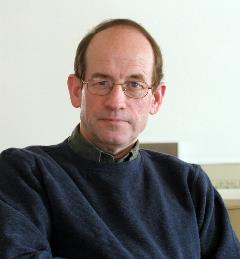 Tell us a little bit about yourself and your work.
Tell us a little bit about yourself and your work.
I was born in a small town in Ohio in 1946. I received a BFA in Sculpture from the Cleveland Institute of Art, Cleveland, Ohio in 1969 and an MFA in Sculpture from Cranbrook Academy of Art, Bloomfield Hills, Michigan in 1973. I studied sculpture at the Skowhegan School of Painting and Sculpture, Skowhegan, Maine 1967 and glass at the Toledo Museum of Art, Toledo, Ohio from 1970-71.
I am Professor Emeritus, College for Creative Studies. I taught at CCS for 40 years. Currently I indulge myself in the studio, conceptualizing and creating art.
Fire began to dominate my art in 1969, the first time I tried to blow glass. As a sculptor, I was forging steel into “form.” Molten glass was an alternative: a hot, quick and scary medium to make art. Once I immersed myself in the glass process, the material became a “fine art” medium for me. 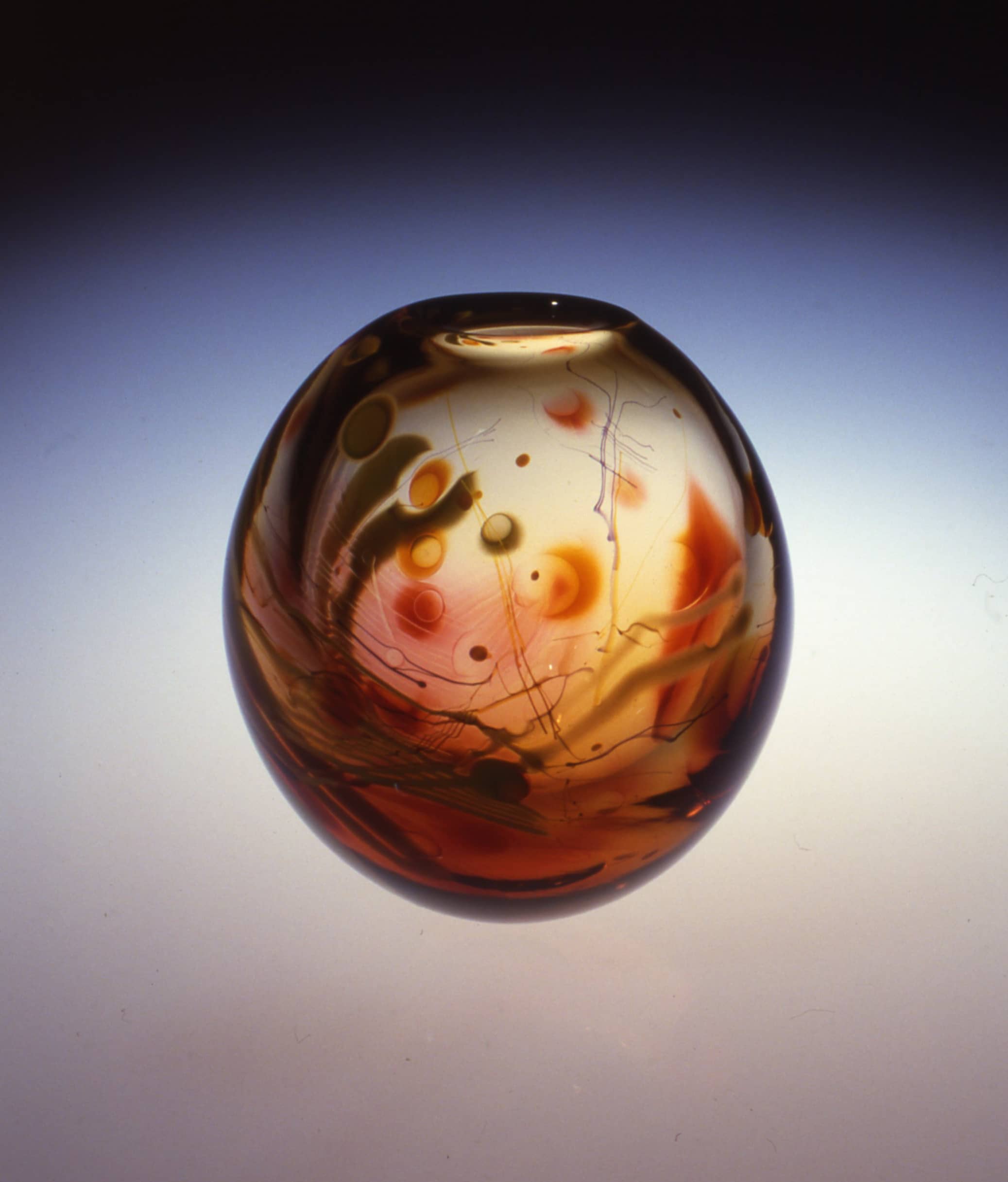
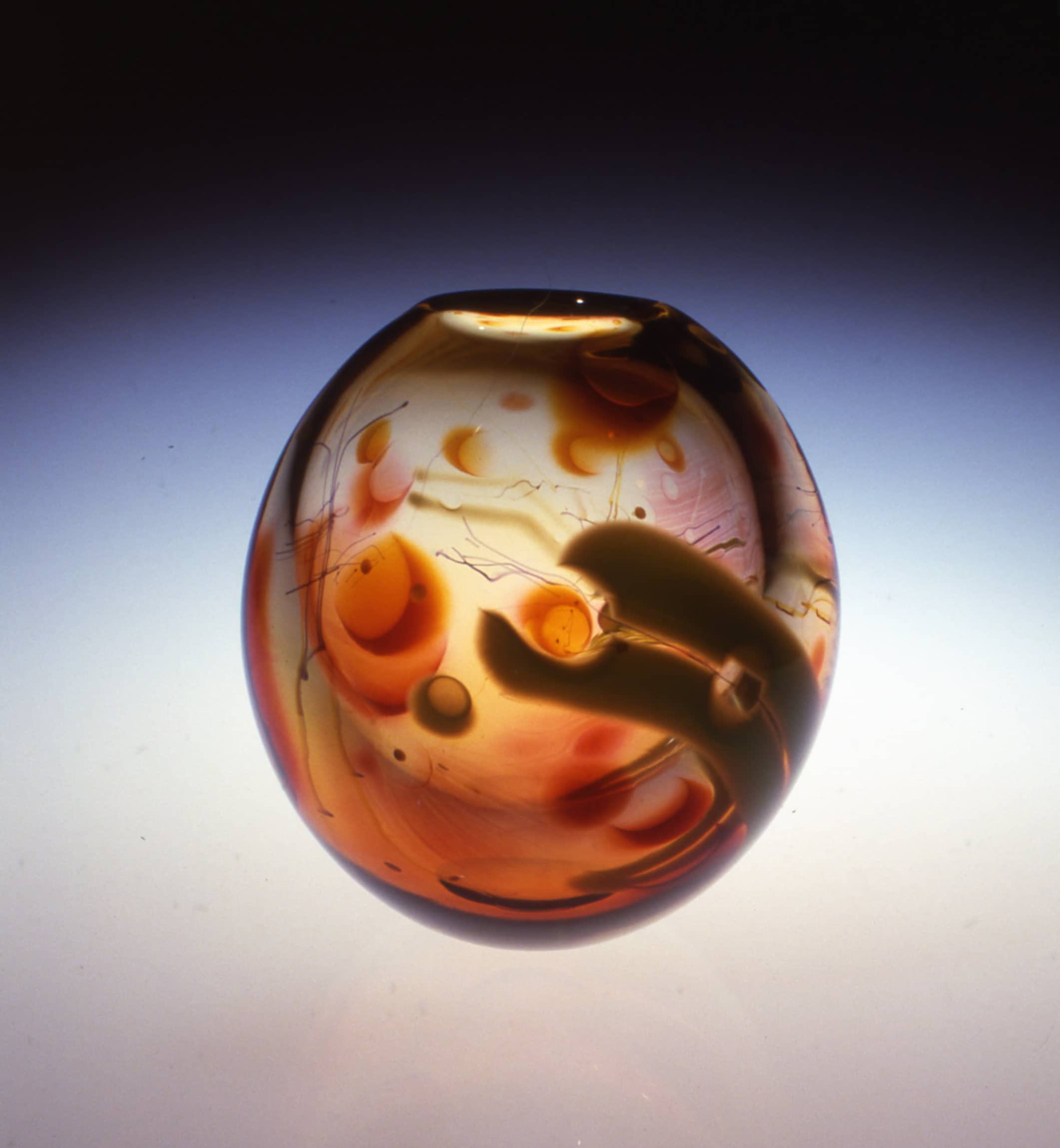
As my glass skills evolved and I explored a new process, I created the Image Vessel Series in 1976. In this series, I “painted” using color and line, and “sculpted” to produce a three-dimensional image through a blown-glass vessel.
Do you have a favorite piece you’ve created?
Not one favorite piece; however, each step in the evolution of my work has produced several pieces that I believe interpret what I am trying to say.
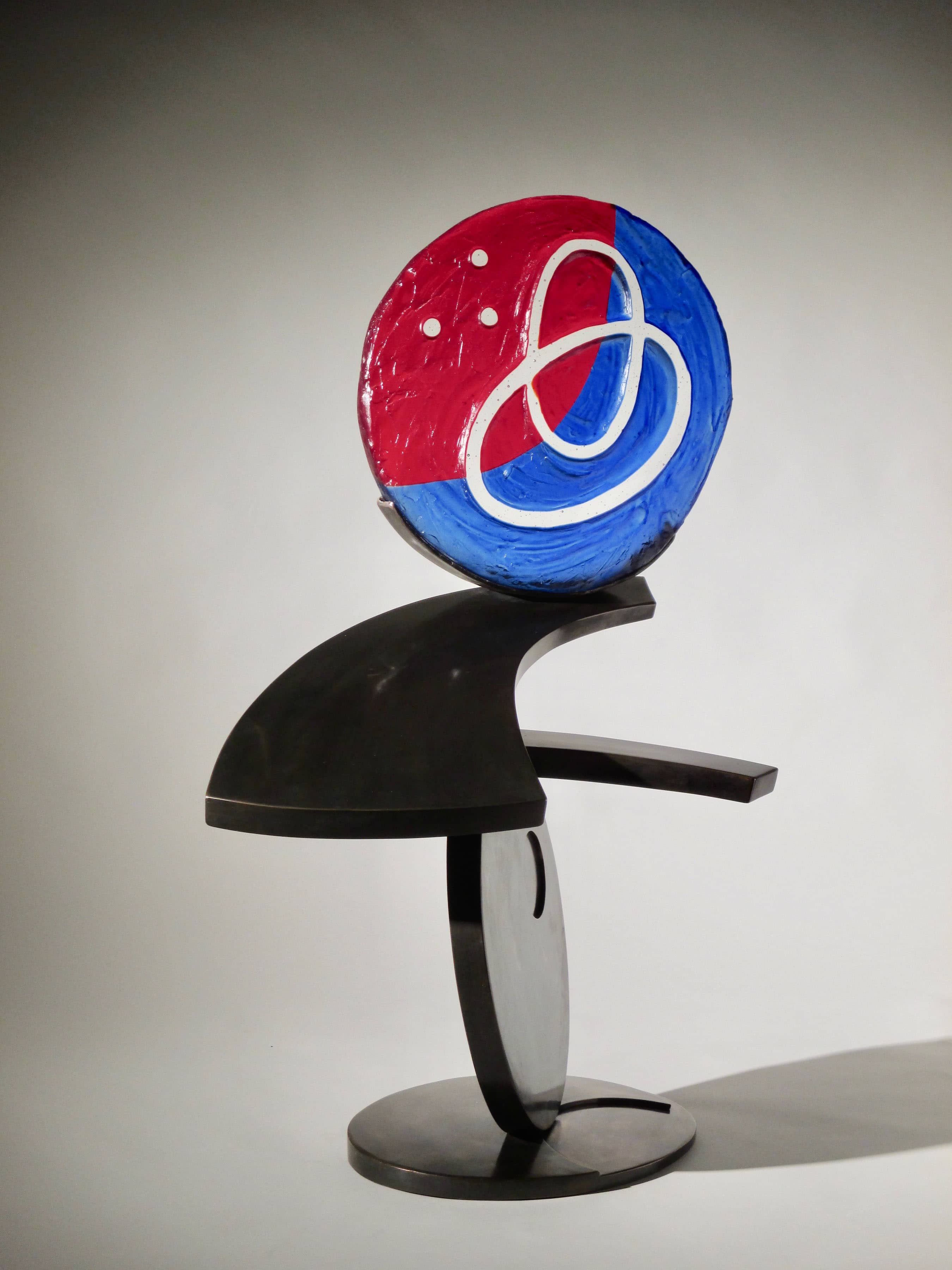
Why do you enjoy working with glass?
The three-dimensional world is reflected light and shadow. Glass adds transparency and translucency. Together this considerably expands the vocabulary of sculpture.
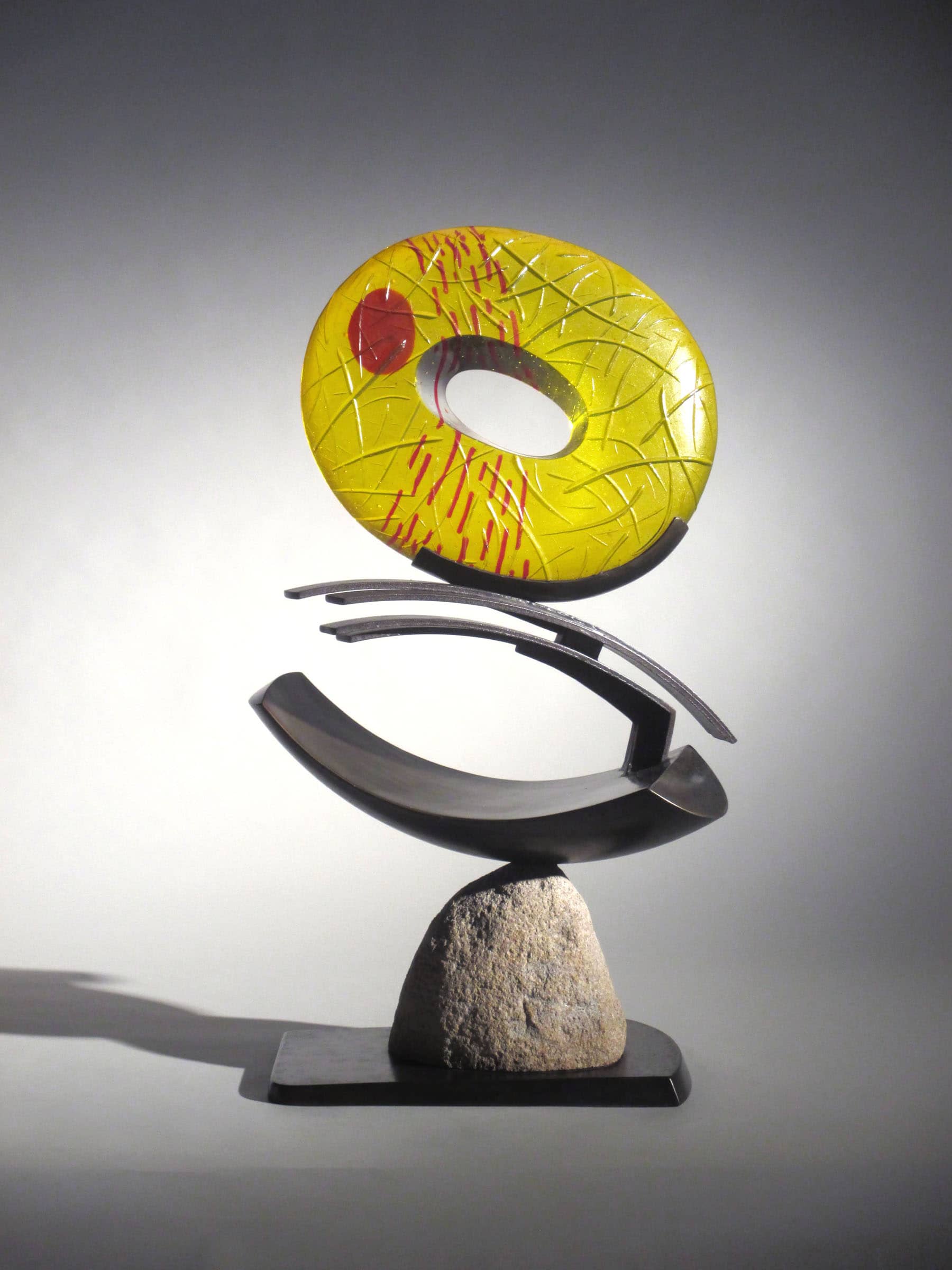
Where do you find your inspiration for your creations?
Inspiration comes from the “human figure” along with its movement and stance.
What are you most looking forward to while being an Artist in Residence at The Henry Ford?
I look forward to working with the highly skilled artisans that make up the Henry Ford glass studio. I hope to produce a three- dimensional interpretation of my Image Vessel Series.
Michigan, Dearborn, 21st century, 20th century, making, Greenfield Village, glass, artists in residence, art
Artists in Residence at The Henry Ford

Artist in Residence Hiroshi Yamano at work in the Greenfield Village Glass Shop.
Art in action. It’s one thing to admire a sculpture made of glass through the display case, studying the technique and artistry from afar. How do you take such art appreciation to the next level? Put it into action?
That’s the question Charles Sable, curator of decorative arts, and Joshua Wojick, master glassblower at the Greenfield Village Glass Shop, pondered as they thought about what’s next for The Henry Ford’s studio glass collection.
“We wanted to broaden our involvement with studio glass,” said Sable, the curator behind of The Henry Ford’s two new glass galleries, which feature studio glass. “We didn’t want the collection to become static. We wanted to express our commitment to studio glass, and glass in general, in ways that would keep our visitors engaged long into the future.”
Added Wojick, “We wanted to continue to build on the studio glass collection, build on its connection to The Henry Ford and create more of a story — our own story — that would be integrated into each object.”
That story’s next chapter comes in the form of an artist-in-residence program. This spring and summer, the Glass Shop hosts a quartet of renowned glass artists, as talented as they are different in their approaches. The program is a first of its kind for the Glass Shop.
In May, Japanese glass artist Hiroshi Yamano kick-started the program, spending five days in the Glass Shop working with The Henry Ford’s artisans and giving visitors a close-up view of his creative process. Formally trained sculptor and glass artist Herb Babcock will also take up temporary residence in the village, along with Marc Petrovic (several of his pieces are part of The Henry Ford’s Bachmann studio glass collection) and technical glassblower Janusz Pozniak.
“We wanted artists that were willing to share their individual artistic process with the public at large,” said Wojick. “Within our shop, we show the public mostly early American glass. This program opens up our studio for the first time, really giving us a chance to show visitors how contemporary artists work, implement designs, collaborate and meld concepts into the physical.”
The pièce de résistance of the program — each artist will leave behind a one-of-a-kind finished piece that will undoubtedly add to the evolving story of The Henry Ford’s glass collection.
artists in residence, making, Greenfield Village, glass, art
Building a Brand… with Buildings

Thanks to Walter Dorwin Teague’s design, Texaco service stations projected a clean, modern and – perhaps most importantly – instantly recognizable image. (From the Collections of The Henry Ford.)
Walter Dorwin Teague’s Texaco Stations
Gasoline is a fiercely competitive business. We’ve all seen intersections with two, three, even four rival gas stations clumped together. Standing out from the crowd is a must. Over the years, retailers developed any number of ways to set themselves apart, including everything from unusual architecture to ultra-clean restrooms. Brand identity – in whatever form it might be – was an essential part of the business.
The Texas Company, better known by the portmanteau Texaco, had its origins in the great Spindletop, Texas, oil strike of 1901, which suddenly had the United States awash in cheap petroleum. Unlike its competitors, which focused on regional markets, Texaco was determined from the start to build itself into a national brand. By 1942, the company had 40,000 outlets spread across the country.
One of Teague’s Texaco stations in use – appropriately enough, in Texas. (John Margolies Roadside America Transparencies. From the Collections of The Henry Ford.)
In 1934, Texaco hired industrial designer Walter Dorwin Teague to create a fresh, unified look for the company’s service stations. Teague came up with a boxlike building covered in white porcelain enamel. Evocative of the then-popular streamlined look, Teague’s design simultaneously suggested speed, modernity and cleanliness. (And, with that porcelain exterior, it was easy to clean.) The gleaming white surface contrasted sharply with its surroundings, wherever the station was located, and readily caught motorists’ eyes. It was easy to illuminate at night, too – a significant benefit for retailers operating around the clock. In time, some 10,000 Teague stations were built across the United States, giving Texaco outlets a consistent appearance and identity.
The basic box building became popular with many of Texaco’s competitors, too. Eminently practical, the design provided space for an office/service counter, automobile service bays, storage, and the all-important restrooms. Furthermore, it could be expanded (or reduced), as business conditions warranted, without harming the building’s overall appearance.
By the 1970s, porcelain enamel was out and darker concrete, brick and wood surfaces were in. (John Margolies Roadside America Transparencies. From the Collections of The Henry Ford.)
But what was fresh and modern in the 1930s was, inevitably, dull and outdated within a few decades. In the 1960s, oil companies began to move away from bright porcelain boxes in favor of more subdued brick facades and gabled roofs. By the 1980s, the box plan itself was superseded by the larger convenience stores we still see today. But Walter Teague’s design lives on in the Driving America exhibit. Our Texaco station was built and operated in Kingston, Massachusetts, before it came to Henry Ford Museum of American Innovation in 1987. The station may not be selling gas anymore, but the its gleaming porcelain still attracts plenty of visitors!
Matt Anderson is Curator of Transportation at The Henry Ford.
Driving America, Henry Ford Museum, roads and road trips, design, by Matt Anderson
The Logan County Courthouse Story
As we look forward to the Greenfield Village opening of 2017, our guests and staff alike enjoy reconnecting with our amazing array of historic buildings. Each of them not only represent different periods of American history, they also hold so many fascinating stories. Among the more interesting, are how they came to have new lives here in Greenfield Village. The Logan County Courthouse’s story is among my favorites.
Abraham Lincoln featured prominently in Henry Ford’s plans for Greenfield Village which revolved around the story of how everyday people with humble beginnings would go on to play important roles in American history. Henry Ford was a “later comer” to the Lincoln collecting world, but with significant resources at his disposal, he did manage to secure a few very important items. The Logan County Courthouse is among them. Logan County Courthouse as it stands today in Greenfield Village.
Logan County Courthouse as it stands today in Greenfield Village.
Authenticated objects, related to Lincoln’s early life, were especially scarce by the late 1920s.There seemed to be an abundance of items supposedly associated and attributed to Lincoln, especially split rails and things made from them. But very few of these were the real thing. For Henry Ford, the idea of acquiring an actual building directly tied to Abraham Lincoln seemed unlikely.  Logan County Courthouse September of 1929.
Logan County Courthouse September of 1929.
But, in the summer of 1929, through a local connection, Henry Ford was made aware that the old 1840 Postville/ Logan County, Illinois courthouse, where Lincoln practiced law, was available for sale. The 89-year-old building, was used as a rented private dwelling, and was in run down condition, described by some as “derelict”. It was owned by the elderly Judge Timothy Beach and his wife. They were fully aware of the building’s storied history, and had made several unsuccessful attempts to turn the historic building over to Logan County in return for funding the restoration, and taking over its on-going care and maintenance. View of rear section of building with shed addition, September 1929
View of rear section of building with shed addition, September 1929
Seeing no other options, the Beaches agreed to the sale of the building to Henry Ford via one of his agents. They initially seemed unaware of Henry Ford intentions to move the building to Greenfield Village, assuming it was to be restored on-site much like another historic properties Ford had taken over. The local newspaper, The Courier, even quoted Mrs. Beach as saying “she would refund to Mr. Ford if it was his plan to take the building away from Lincoln, as nothing was said by the agent about removal”. By late August of 1929, the entire project in West Lincoln, Illinois, had captured the national spotlight and the old courthouse suddenly had garnered a huge amount of attention, even becoming a tourist destination.
 View of side currently adjacent to Dr. Howard’s Office, September, 1929. This view shows evidence of filled in window openings. The window currently behind the judge’s bench was restored.
View of side currently adjacent to Dr. Howard’s Office, September, 1929. This view shows evidence of filled in window openings. The window currently behind the judge’s bench was restored.
By early September, local resistance to its removal was growing, and Henry Ford felt the need to pay a visit to personally inspect the building and meet with local officials, and the Beaches. He clearly made his case with the owners and finalized the deal. As reported, “Ford sympathized with the sentiment of the community but thought that the citizens should look at the matter from a broader viewpoint. He spoke for the cooperation of the community with him in making a perpetual memorial for the town at Dearborn, where the world would witness it. My only desire is to square my own conscience with what I think will be for the greatest good to the greatest number of people.”




Views of partitioned first floor, summer 1929.
The courthouse would indeed be leaving West Lincoln, and by September 6, Henry Ford’s crew arrived to begin the process of study, dismantling, and packing for the trip to Dearborn. Local resistance to the move continued as the final paperwork was filed, and the newly purchased land was secured by Ford’s staff. By September 11, the resistance had run its course and the dismantling process began. It was also revealed that the city, county, several local organizations, and even the state of Illinois had all been offered several opportunities to acquire the building and take actions to preserve it. They all had declined the various offers over the years. It was then understood that Judge & Mrs. Beach, in the end, had acted on what was best for the historic building and should not be “subjected to criticism.” Judge Beach would die a week later, on September 19th.
The dismantling and discovery process was closely covered by the local newspapers, and as the building came apart, its original design was revealed.
Beginning as early as the late 1840s, changes had taken place on both the exterior and interior of the building. By 1880, the building had been converted from a commercial building into a dwelling and that was the state in which it was found by Ford’s crew in 1929. The doorway and first floor interior had been radically changed and eventually, a covered porch was added to what is now the main entrance, and a shed addition to the rear. But, the most significant change, was the move off its original foundation, 86 feet forward on the lot.
In 1848, the county seat moved from Postville, to Mount Pulaski. At that time the courthouse was decommissioned, and after a legal battle between the County, and the original investor/builders of the building, it was sold to Solomon Kahn. None other than Abraham Lincoln successfully represented the County in the matter. Mr. Kahn converted the building into a general store, and ran the local post office within. It was he who moved the building to its new location. In doing so, the old limestone foundation was left behind, and the original limestone chimney and interior fireplaces were demolished. A new brick lined cellar and foundation was created, along with updated internal brick chimneys on each end of the building, designed to accommodate cast-iron heating stoves. This took place before 1850.
 The oldest know photograph of the Logan County Courthouse c.1850-1880. The original door arrangement remains in place.
The oldest know photograph of the Logan County Courthouse c.1850-1880. The original door arrangement remains in place.
Photographs taken in September of 1929, show the outline of the original chimney on the side of the building where it has been re-created today. Further discoveries revealed the original floor plan of a large single room on the first-floor, and the original framing for the room divisions on the second. Second floor photographs show the original wall studs, baseboards, chair rails, window, and door frames, all directly attached to the framing, with lath and plaster added after the fact. The framing of the walls on the first floor were all clearly added after the original build. The oldest photograph of the courthouse shows it on its second site with its original window and door arrangement still in place, but with new brick chimneys. The photo dates from between 1850 and 1880.
It was some of the older inhabitants of the area that alerted Henry Ford’s staff as to the original location of the foundation. Once located, the original foundation revealed the dimensions of the original first-floor fireplace. All the stones were carefully removed and shipped to Dearborn. The courthouse rests on this foundation today. The local newspaper also reported that while excavating the foundation, a large key and doorknob were found at the edge, aligned where the front door would have been located.
 View of side that currently faces Scotch Settlement School, September, 1929. Shadow of original stone chimney is visible. Patched sections of siding show that originally, the stone would have been flush with the siding until approximately the top third, which would have extended out from the building like the entire chimney currently does. The window and door are late additions.
View of side that currently faces Scotch Settlement School, September, 1929. Shadow of original stone chimney is visible. Patched sections of siding show that originally, the stone would have been flush with the siding until approximately the top third, which would have extended out from the building like the entire chimney currently does. The window and door are late additions.
By September 20th, the building, consisting of two car loads of material, was on its way to Dearborn. Reconstruction in Greenfield Village began almost immediately at a frenzied pace. Finishing touches were still being applied right up until the October 21st dedication of Greenfield Village. Edward Cutler oversaw the final design elements needed to restore the building along with the actual work of reconstructing it. All the first- floor details, including the fireplace, mantle, and judges bench had to be re-created. The first-floor interior trim was reproduced in walnut, and was based on the original trim that survived on the second floor. The second floor, using a large amount of original material, including flooring, was also restored to its original appearance. Even the original plaster was collected, re-ground, and used to re-plaster the interior walls.

 Views of the excavated original foundation, located 86 feet back from building’s second location. Lower view shows foundation for the original fireplace. September, 1929.
Views of the excavated original foundation, located 86 feet back from building’s second location. Lower view shows foundation for the original fireplace. September, 1929.
Based on the oldest of the original photographs, all new windows and exterior doors were also reproduced. Where possible, the original exterior walnut siding was also restored, and re-applied to the building and secured with brass screws.This was not a period technique, but rather a solution by Cutler to ensure the original siding with its worn nail holes, would stay in place.
The result was a place where Henry Ford could now display, and share his collection of Lincoln associated artifacts, including the most famous of all, the rocking chair from the presidential booth in Ford’s theater where Abraham Lincoln was sitting when he was shot by John Wilkes Booth in April of 1865.
 Re-construction well under way in Greenfield Village on October, 2, 1929. The building would be complete for the October 21, dedication. The Sarah Jordan Boarding House can be seen in the distance.
Re-construction well under way in Greenfield Village on October, 2, 1929. The building would be complete for the October 21, dedication. The Sarah Jordan Boarding House can be seen in the distance.
 The completed Logan County Courthouse in Greenfield Village as it appeared for the October 21 dedication.
The completed Logan County Courthouse in Greenfield Village as it appeared for the October 21 dedication.

The newly unpacked Ford’s Theater rocking chair in the Logan County Courthouse, January of 1930.
 The interior of the completed Logan County Courthouse c.1935. It featured a display of Abraham Lincoln associated objects including Springfield furniture and the rocking chair from Ford’s Theater.
The interior of the completed Logan County Courthouse c.1935. It featured a display of Abraham Lincoln associated objects including Springfield furniture and the rocking chair from Ford’s Theater.
From 1929 until the mid-1980s, the building was left almost untouched as a shrine to Abraham Lincoln.
It was not until the mid-1980s that the research material was re-examined, primarily for preparations for much needed repairs to the now 50 plus year old restoration. In 1980, prior to the restoration work, the Lincoln assassination rocking chair was removed from the courthouse and placed in Henry Ford Museum. In 1984, the building underwent a significant restoration and was re-sided, the first- floor flooring was repaired, and extensive plaster repair and refinishing took place. In addition, a furnace was added (inside the judge’s bench), to provide adequate heat.
The interpretation of the building also was redefined and was re-focused away from the Abraham Lincoln shrine and more toward the stories of the history of our legal system and the civic lives of Americans in the 1840s. Gradually, many of the Lincoln artifacts were removed to appropriate climate controlled storage or display in Henry Ford Museum.
That brings us to the Greenfield Village opening of 2017. The Logan County Courthouse has now stood as long in Greenfield Village as it did in Postville, 88 years. It has had an interesting and storied history in both locations. Both the curatorial team, and the Greenfield Village programs team are excited to continue the process of ongoing research and improving the scholarship of the stories we tell there. We are working on some projects to accomplish just that for the near future and are looking forward to sharing all the details.
Continue ReadingHenry Ford, Michigan, Dearborn, Illinois, 20th century, 19th century, presidents, Logan County Courthouse, Greenfield Village history, Greenfield Village buildings, Greenfield Village, by Jim Johnson, Abraham Lincoln
Detroit Autorama 2017: A Car Show Like No Other

“Madam X,” a 1939 Cadillac Sixty Special and one of the stars of the 2017 Detroit Autorama.
The car show season usually feels far away in late February. (Usually. Maybe not this year, when Detroit temperatures have already approached 70 degrees.) But the weekend of February 24-26 brought us a tease of the top-down, volume-up cruising weather to come. More than 800 cars filled Cobo Center for the 65th annual Detroit Autorama, among the most important shows in the hot rod and custom car hobby. The VW Beetle-based “Baja Bandeeto,” showing that presentation is everything.
The VW Beetle-based “Baja Bandeeto,” showing that presentation is everything.
Naturally, Autorama doesn’t simply open the doors to kick off the event. No, it starts with something special. This year launched with a nod to The Dukes of Hazzard, the downhome television series that undoubtedly influenced every Autorama participant born between 1970 and 1980. The Northeast Ohio Dukes stunt show team patched together a derelict Dodge Charger, gave it the necessary orange paint, and jumped it 134 feet over Atwater Street, just outside Cobo Center. The flight was fantastic, but the landing… well, that Charger needs more care than Cooter Davenport can give it if it’s ever going to fly again. “More Aggravation,” recipient of the very first Ridler Award in 1964.
“More Aggravation,” recipient of the very first Ridler Award in 1964.
Autorama’s top prize is the revered Ridler Award, named for early show promoter Don Ridler. Qualifying cars cannot have been shown publically prior to Autorama. Judges announce their “Great 8” – the eight finalists – at the Ridler’s Ball on Friday night. For the rest of the weekend, anticipation builds until the winner is revealed at the end of Sunday’s awards ceremony. The winning owner earns a small piece of immortality, with her or his name forever engraved on the trophy and added to the Winner Archive, and a not-so-small chunk of change in the form of $10,000. This year’s Ridler Award went to “Renaissance Roadster,” a scratch-built 1933 Ford powered by a GM big-block 427 crate engine. One of the Rat Rods – the deliberately under-restored cars – that populated Autorama Extreme on Cobo Center’s lower level. Even in this condition the ’55 Chevy’s inherent beauty shines through.
One of the Rat Rods – the deliberately under-restored cars – that populated Autorama Extreme on Cobo Center’s lower level. Even in this condition the ’55 Chevy’s inherent beauty shines through.
For the fourth year, The Henry Ford presented its Past Forward award. With the prize, we look to honor a car that 1.) Combines traditional inspirations with modern innovations, 2.) Exhibits a high level of skill in its construction, 3.) Captures the “anything goes” attitude of the hot rod and custom car hobbies, and 4.) Is just plain fun. “Pearl Necklace,” winner of The Henry Ford’s Past Forward award for 2017.
“Pearl Necklace,” winner of The Henry Ford’s Past Forward award for 2017.
For 2017, we found all of those qualities in “Pearl Necklace,” a 1959 Ford Galaxie 500 built and owned by John Oberg and Roy Oberg. Apart from the pearlescent paint that inspired its name, and the beautiful marbled wheels (with retro Ford Motor Company logos on the hubs), “Pearl Necklace” could almost pass for stock. But this Galaxie’s a sleeper. The 352 V-8 was bored out by .020 inches, the stock differential was replaced with a 3.73 gearset for faster launches, and the transmission was replaced with Ford’s rugged C6 automatic to handle extra torque. Not that the car was too shabby even when originally built. Plaques on the door proudly boast that it’s “Air Conditioned by Ford Select Aire,” a ritzy option that accounted for almost 20 percent of the original $2,500 sticker price! This 1979 Pontiac Firebird Trans Am was pointed west in Cobo Center, but it was eastbound in spirit.
This 1979 Pontiac Firebird Trans Am was pointed west in Cobo Center, but it was eastbound in spirit.
But the best thing about “Pearl Necklace” was simply this: The car was a labor of love, built by John and Roy (with help from one or two friends) in a two-car garage over the course of 26 years. It’s that kind of dedication that makes a custom car special – and makes the Detroit Autorama a car show like no other.
Matt Anderson is Curator of Transportation at The Henry Ford.
21st century, 2010s, Michigan, Detroit, cars, car shows, by Matt Anderson, Autorama
Math, Music, and the Matrix
This scene could almost be a slick DJ club set, but there are no knobs, decks or instruments in sight. Yet the code is real, and it’s all live.
This is the world of live-coding music, an art form in which performers create music by programming computers on the fly, in front of an audience, writing and revising instructions that trigger and manipulate sounds, rhythms and effects in real time.
THE MATH OF MUSIC
When it comes to expressing musical ideas, computer programming might seem an unlikely outlet. But computer science is grounded in math, and music, with all of its messy, imprecise human expression, is largely built on mathematical relationships — harmonic structure, rhythmic patterns, and at its most fundamental, the unique combinations of sine waves that make up the sounds all around you, from birdsong to the roar of a jet engine.
We’ve been exploring parallels between music and math since the days of Pythagoras. Today, musicians and composers are able to use computers as tools to interpret and express these values and relationships.
“It’s clearer through coding that music can be expressed as essentially patterns of numbers that are processed and transformed in various ways — and that we can add expressivity by changing the sounds we are using and shaping the structure of our sounds,” said Shelly Knotts, a composer, experimental artist and live coder in the United Kingdom.
As a live coder learns to anticipate these mathematical relationships, his or her ears learn to “hear” the relationships, much like in traditional music theory training. Live coders often write code that they can hear in their heads — which, at a fundamental level, relates to Beethoven’s ability to continue composing even after he had completely lost his hearing.
BREAKING DOWN BARRIERS
Live-coding languages and styles vary. Most performers create music entirely on the fly, constructing ideas from scratch; a few mix in precoded elements, DJ-style. But they all embrace the movement’s overarching philosophy that live coding should be inclusive and accessible to everyone.
For most live coders, exposing their code is part of the performance and serves to demystify their process, forging a connection with the artist through his or her “instrument,” explained Sam Aaron, a British researcher, software architect, educator and live coder. “Why is it important for a guitarist to let you see his or her guitar? People have all held guitars; most of us are not very good at it, so when you see someone who’s good at it, you can appreciate the virtuosity.”
There’s no denying that projecting computer code adds a compelling visual element to a performance, but if you’re not paying attention to the language itself, you’re missing the point. “It’s like saying Jimi Hendrix made amazing music, but he had a fabulous wooden necklace,” added Aaron.
Live coding challenges preconceived ideas about the programmer’s experience by bringing a traditionally solitary process into a participatory realm. “It’s like writing, really; you don’t generally write in a social way,” said British musician and researcher Alex McLean, member of the live-coding band Slub and cofounder of TOPLAP, an organization formed in 2004 to bring live-coding communities together. “I think live coding is not necessarily showing programmers as something different, but rather a different way of interacting with the computer; it’s very different, working alone on a piece of text and having people in front of you, listening intently,” added McLean, who is also credited with co-inventing the algorave, a rave-like club event based around live coding.
Since its inception about 15 years ago, live-coding culture has been rooted largely in Europe and the U.K., but the movement is slowly building international interest through festivals and other live events, long-distance collaborations over video and social media, and creative partnerships with more mainstream artists. But the most powerful force for longevity is education, and right now, it’s Aaron holding the key.
CRACKING THE CODE
“I want to make sure the leap from code to music is as small as possible and as clear and simple to as many people as possible,” said Aaron, a passionate advocate for unearthing the creative potential of programming languages. He spends his days as a researcher at the University of Cambridge in England and his nights performing live coding.
In 2012, Aaron created Sonic Pi, a simple yet powerful open-source programming environment designed to enable users at any level to learn programming by creating music and vice versa. Sonic Pi is used all over the world; it runs on any computer platform including Raspberry Pi, the $40 credit card-sized computer designed for DIY projects and for promoting computer science in schools and developing countries.
“Music really helps by wrapping the math concepts and computer science concepts into something that has direct meaning to kids, which is making music,” Aaron said. “And making the kind of music, hopefully, that they listen to on the radio or stream.”
The case for building these new learning paths to computer science is strong. Understanding basic programming improves logical thinking and provides a fundamental understanding of technology we use every day.
“Teaching people what coding is — how precise a language has to be for a computer to understand it — gives people an appreciation of an execution of semantics in a program, affordances of a system, interaction with a system,” said Aaron. “People are telling kids to learn how to program because they can become professional programmers. It’s like saying we should all do sports in school so we can become professional athletes. You don’t teach math because you’re training the future mathematicians. There’s a level of math that’s useful to all of our lives."
Sarah Jones is a writer for The Henry Ford Magazine. This story originally ran in the March-May 2017 issue.
computers, technology, music, by Sarah Jones, The Henry Ford Magazine
Another Thought on NAIAS 2017

I’ve already shared some thoughts on the 2017 North American International Auto Show, but one important new car wasn’t yet revealed during my visit last week. Of course, I’m talking about the LEGO Batmobile from Chevy.
My tastes in bat-transportation run more traditional, but Chevy has something going for it here. The LEGO Batmobile’s 20,000-horsepower rating makes it eight times as powerful as the Goldenrod land speed racer. Likewise, the V-100 engine’s 60.2-litre displacement is more than eight and a half times what it took for the Mark IV to win at Le Mans fifty years ago. The LEGO Batmobile’s styling achieves that rare combination of aerodynamic and exquisite, certain to turn heads on every street corner. Be sure to order the optional bat hood ornament – superior to anything by Lalique. (Besides, everybody knows that bats eat dragonflies.)
Continue Reading21st century, 2010s, toys and games, NAIAS, Michigan, LEGO, Detroit, cars, car shows, by Matt Anderson
Mrs. Cohen: A Fashion Entrepreneur

Life is often a juggling act of work, play and family. While current-day clothiers experience the trials and tribulations of being small-town entrepreneurs in the big business of fashion, more than 100 years ago many women were facing similar circumstances, leaning on their sense of style to furnish a living.
In the late 1800s, Elizabeth Cohen had run a millinery store next to her husband’s dry goods store in Detroit. When he died and left her alone with a young family, she consolidated the shops under one roof. Living above the store, she was able to run a business and earn a living while staying near her children.
Cohen leveraged middle-class consumers’ growing fascination with fashion, using mass-produced components to create hats in the latest styles and to the individual tastes of customers. To attract business, resourceful store owners like Mrs. Cohen displayed goods in storefront windows and might have advertised through trade cards or by placing advertisements in newspapers, magazines or city directories.
“While Mrs. Cohen was more likely following fashion than creating it, it did take creativity and design skill,” Jeanine Head Miller, curator of domestic life at The Henry Ford, said of Cohen’s millinery prowess. “She was a small maker connecting with local customers in her community — a 19th-century version of Etsy, perhaps, but without the online reach.”
And she certainly gained independence and the satisfaction of supporting her family while selling the hats she created from the factory-produced components she acquired. “People can appreciate the widowed Elizabeth Cohen’s balancing act,” added Miller, “successfully caring for her children while earning a living during an era when fewer opportunities were available to women.”
Jennifer LaForce is a writer for The Henry Ford Magazine. This story originally appeared in the June-December 2016 issue.
19th century, women's history, The Henry Ford Magazine, shopping, Michigan, making, hats, Greenfield Village buildings, Greenfield Village, fashion, entrepreneurship, Detroit, design, Cohen Millinery, by Jennifer LaForce

